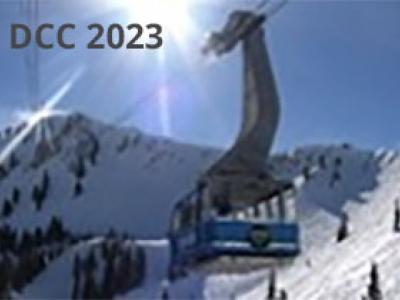
DCC 2023 Conference - The Data Compression Conference (DCC) is an international forum for current work on data compression and related applications. Both theoretical and experimental work are of interest. Visit the DCC 2023 website.

- Read more about Novel Foreground and Background Separation Based Multi-level Coding Framework for Indoor Surveillance Video
- Log in to post comments
There is larger compression potential for surveillance video coding due to the inherent superredundancy in fixed camera scenarios, which is not fully utilized in the general-purpose MPEG-like video coders. In this paper, we propose a novel compression framework for indoor surveillance video in which the background and foreground humans are separately compressed. Since the indoor surveillance video’s background is static, the background is extracted and shared between frames.
- Categories:
 34 Views
34 Views
- Read more about Video Transformer based Video Quality Assessment with Spatiotemporally adaptive Token Selection and Assembly
- Log in to post comments
Video quality assessment (VQA) for user generated content (UGC) videos plays important role in video compression and processing. Convolutional neural network (CNN) based quality assessment for UGC is the research focus with inspiring model accuracy increment in the past three years. However, regularly temporal-sampling with temporal feature loss, as well as fixed token selection strategy video transformer (ViT) with insufficient representational capacity of tokens, jointly degrade the accuracy of conventional ViT based quality assessment.
- Categories:
 79 Views
79 Views
In the paper highly ecient algorithm for lossless image coding is described. Its high data compaction performance is obtained at the expense of computational complexity, still being not as high as for other top rated methods. The algorithm is based on predictor blending principle, outputs of 27 dierent sub-predictors are combined, hence its name Blend-27. Eciency of Blend-27 is tested on a set of 15 usually used benchmark images, and compared to that of over 20 methods, including the best known ones.
- Categories:
 41 Views
41 Views
A common approach for enabling remote radiologists to view medical images is to provide them with secure access to a cloud instance using a web-based application. Such solutions must transcode input images or videos to low latency, lossless bit streams and make them available to remote users. The heart of the solution is the highly efficient, low-latency, and hardware-agnostic compression scheme. This poster surveys potential codecs for the low-latency, lossless compression of 16-bit RAW monochrome medical images and compares the compression ratio and encode time for each.
- Categories:
 30 Views
30 Views
In this paper, we propose a neural implementation of a companded quantization scheme allowing to train and implement optimal scalar quantization in data compression systems based on neural networks. The advantage of companded quantization lies in the fact that it allows to implement optimal non-linear quantization in a simpler form based on uniform quantization. In our work, we consider two different models of uniform quantization. Further on, in order to verify the effectiveness of the proposed approach, we made a series of experiments on natural grayscale images.
- Categories:
 35 Views
35 Views
The wavelet tree is a data structure that indexes a text over an integer alphabet for efficient rank and select queries. Using the Huffman encoding, it can be stored in zero-order entropy-compressed space. We present a highly engineered open source implementation of an efficient sequential construction algorithm that makes use of bit parallelism via vector instructions. On hardware featuring ultrawide registers of up to 512 bits, it outperforms the currently fastest known practical sequential construction algorithms by a factor of up to 2.5.
slides.pdf
- Categories:
 28 Views
28 Views
- Read more about Constructing the CDAWG CFG using LCP-Intervals
- Log in to post comments
It is known that a context-free grammar (CFG) that produces a single string can be derived from the compact directed acyclic word graph (CDAWG) for the same string. In this work, we show that the CFG derived from a CDAWG is deeply connected to the maximal repeat content of the string it produces and thus has O(m) rules, where m is the number of maximal repeats in the string. We then provide a generic algorithm based on this insight for constructing the CFG from the LCP-intervals of a string in O(n) time, where n is the length of the string.
- Categories:
 94 Views
94 Views
- Read more about A Spatial-Focal Error Concealment Scheme for Corrupted Focal Stack Video
- Log in to post comments
Focal stack image sequences can be regarded as successive frames of videos, which are densely captured by focusing on a stack of focal planes. This type of data is able to provide focus cues for display technologies. Before the displays on the user side, focal stack video is possibly corrupted during compression, storage and transmission chains, generating error frames on the decoder side. The error regions are difficult to be recovered due to the focal changes among frames.
- Categories:
 71 Views
71 Views
- Read more about VCSL: Video Compressive Sensing with Low-complexity ROI Detection in Compressed Domain
- Log in to post comments
By exploiting the potential of deep learning, video compressive sensing (CS) has achieved tremendous improvement recently. Due to the video CS is mainly served for the fixed scene in real life. In this paper, we propose a novel video compressive sensing with a low-complexity region-of-interest (ROI) detection method (VCSL). The ROI is located by calculating the difference between the reference frame and the following frames in our framework, which is compact without introducing any additional neural networks and parameters.
- Categories:
 64 Views
64 Views
Canonical binary AIFV coding contains two trees $T_0$ and $T_1$. We show the method to compress $T_0$, and the method to compress $T_1$ is with a similar way. We provide a new method to store the number of leaves, master nodes and complete internal nodes in each layer and compactly encode the string of numbers according to the specific property between the nodes.
- Categories:
 20 Views
20 Views